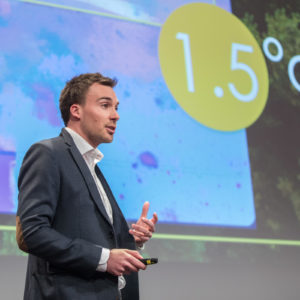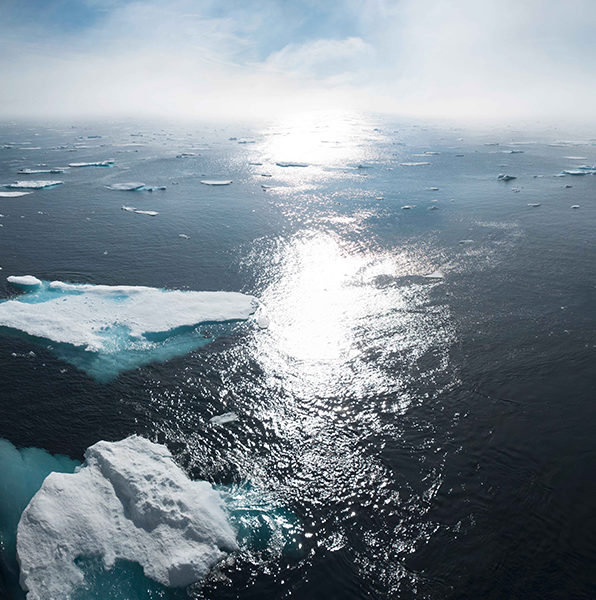Are trees the best weapon against climate change? This question was widely debated after a study by the Crowther Lab at ETH Zürich was published. Managing Director Thomas Elliott reflects in this interview on the practice of science communication, the preparations for the study and the public’s reactions.
“We had a variety of posts ready to be shared”
Mr. Elliott, three months ago the Crowther Lab published their tree potential study, which found that we have space for enough trees to store an additional 205 billion tonnes of carbon. It started off a global debate on reforestation as a tool to mitigate climate change. How has work and life changed in the Crowther Lab since the release?

All in all, it’s been incredibly hectic and exciting. Since the study came out we’ve been flooded with requests for collaborations. Lots of people would like to learn more about the potential for tree restoration in their particular area. So the last few weeks have been a lot about working with organisations on how to use the data in our maps to guide their restoration efforts, including the United Nations and their Forest and Agriculture Organisation (FAO) – who will be using the maps to disseminate more tailored data to governments.
Climate change has been a central issue in the news and a topic of scientific interest for a long time. Still, your study got more attention than other publications in that field. What do you think made this paper to such a talking point?
I think there are a couple of factors that really helped. One being the fact that our study had a simple, positive message. This is a paper emphasising the potential of natural ecosystems. After hearing so much about degradation and what humans have done to those ecosystems over time, we were able to bring the attention to how an ecosystem could help us combating climate change, if restored to its natural state. We believe that ambitious, positive feeling will always be a better enabler of action than fear.
Speaking of action, we also tried to offer suggestions on our website of what people could do with this information: they could use our maps to restore trees, support organisations doing restoration in a sustainable way, or even just be more responsible in the way they consume and support companies that are conscious about their carbon footprint. This can be a really powerful tool in shaping the behaviour of industries which have a much greater influence on the use of land than any individual.
But of course, there’s also an element of timing, of people being interested in natural climate solutions. Six months before the publication we were seeing large multinational companies announcing big restoration projects, and talking about natural climate solutions in their financial statements. Then in March 2019 the United Nations announced the Decade on Ecosystem Restoration. Everybody knew that restoring ecosystems is a good thing, but it had never been quantified. Our study offered global numbers and particular reference points that made it easier to understand the scale of these contributions.
So a combination of timing, the appetite for quantified data, a positive message and tangible actions on an individual level, all probably helped spreading the study.
How did you prepare the release on the communication side of things?
We wanted to think of all the channels of communication we have and prepare a lot of content beforehand. Early on, we produced short videos to go alongside the report, with the authors explaining the paper in simple terms. When July came, we had a variety of social media posts summarizing the main messages, statistics from our map and some interesting infographics ready to be shared – just so that when we got the attention of the media, we could immediately provide them with all the information they need. It took us about two to three weeks to prepare, but unlike most academic research labs, we have communication specialists within the lab as well as external communication support in form of an agency to help with this effort. 
How did the collaboration between scientists and the communication teams look like?
Having some of them within the team and in the same office really helps. For a big paper like this, the communication specialists draft content after a conversation with the researchers and send them for a scientific review. Then it’s a back and forth, in some cases four or five revisions, until we go with something that we are comfortable with. The communication teams have a good sense of what will resonate with the public. It’s their mission to get the messages across and the scientist’s task to make sure that everything is scientifically correct.
Like you said, it’s quite unusual for a science lab to have this amount of support in the communication of their work. Why did you decide to invest that many resources in this area?
Partly it was a really practical decision, the need to outsource some tasks. But also the communication team’s connection to the press and the climate activism community is of great value. Building this kind of a community would take years for us to do.
Whether it be activists, green consultancies or start-ups facilitating the transition to a carbon free economy, many of these climate conscious groups have communications expertise to help them generate interest in the work they’re doing. Science should be a fundamental part of any discussion on the climate, and yet we receive relatively little public exposure. It’s rare that an academic science lab has the resources or expertise to generate a lot of high-level content around their research. I think that’s why new science seems to appear out of a black box. It feels like they surprise us with incredible findings and then disappear again. Personally, I think that it would be good to have a new kind of approach to science where everybody has communication experts and they’re able to position science better and more prominently within the wider debate, especially on climate issues.
Do you see it as the scientists’, or in this case, the lab’s responsibility to not only produce the science, but also sharing and actively communicating it?
Oh absolutely, yes. But scientists have got enough on their plate without being incredible communicators. We’re very lucky that our lab founder Thomas Crowther is a natural communicator; not all scientists are. I personally feel like academia should allow for more funding of communication support. There are more and more communication specialists within science, but having this expertise embedded within a specific research lab is not so typical.
Do you think this will be the new normal at some point?
I like to think it would be. I don’t know the landscape well enough to say it will be, but I think it should be. Particularly given the importance of the topic.
You also received some critique, some saying the data and broader message was “too good to be true”. Would you like to respond to these critics?
Any big paper is undoubtedly going to receive criticism when it has this much attention. And it’s actually really important! First and foremost it engages with a wider audience and broadens the conversation. We need that discourse about the importance of forests, the carbon cycle and the role they play in mitigating climate change. I’d say we’re happy that it generated so much attention and interest. About 95 percent of the attention that we got was incredibly positive.
In terms of the other five percent, we generally agreed with all these criticisms – they were not mutually exclusive with the scope of our study. A lot of people were saying that this is not the silver bullet solution to climate change. And to their point, it’s absolutely imperative that we stop pumping carbon into the atmosphere – that is causing the problem! Others were emphasising the importance of putting a stop to deforestation before reforestation. This is also true, just not part of the research we scoped to look at the restoration of trees.

Hinweis zur Transparenz: Imke Hedder hat vor ihrer Tätigkeit bei Wissenschaftskommunikation.de ein Praktikum beim Crowther Lab absolviert.






